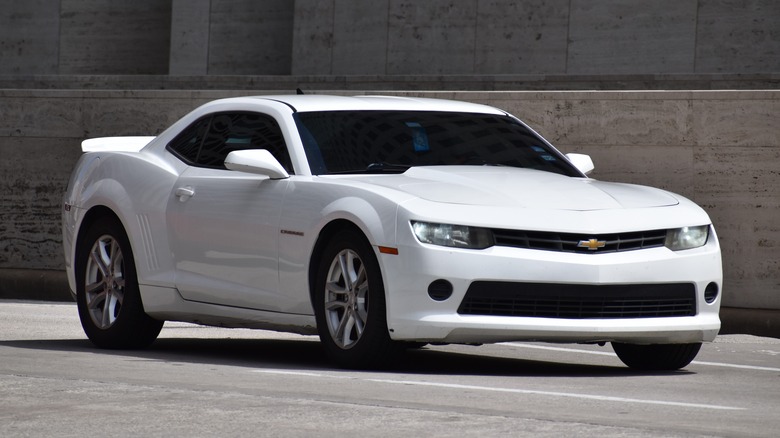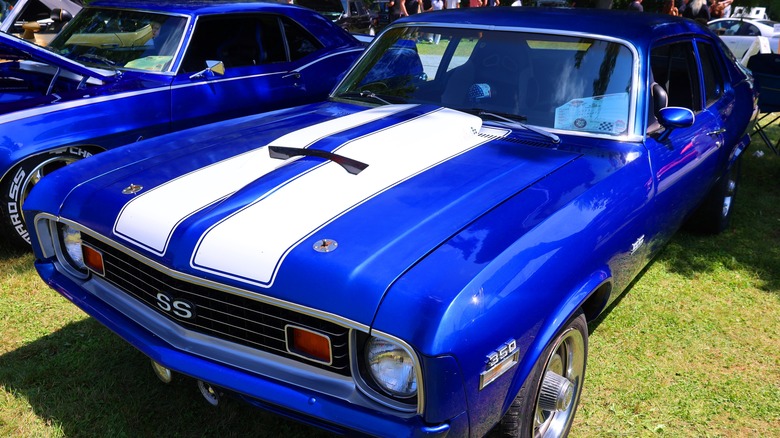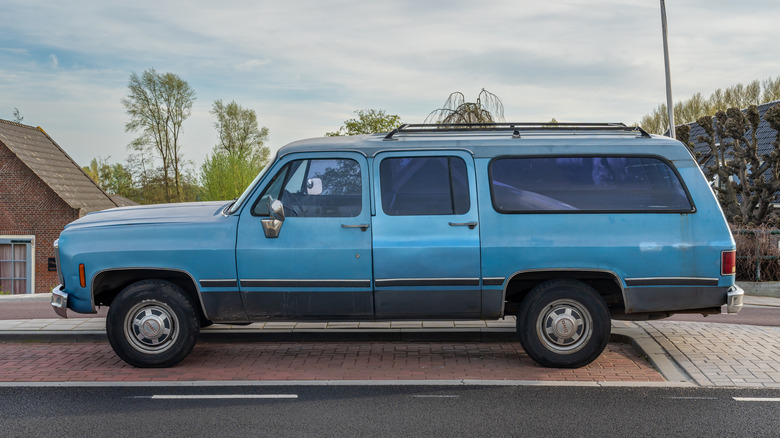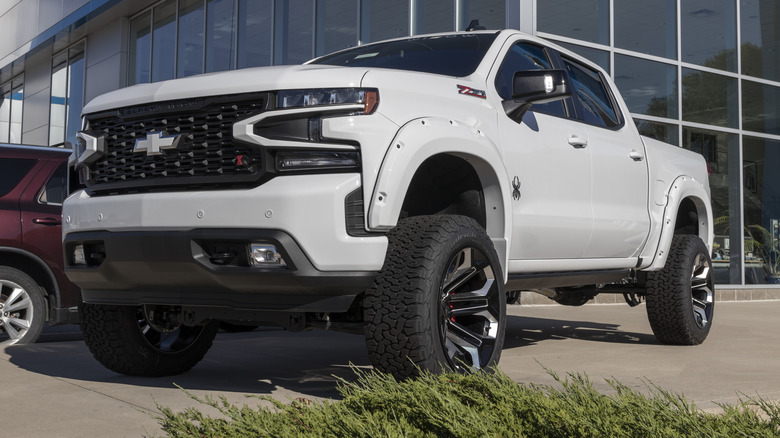
Artistic Operations/Shutterstock
By Joe Hindy/
Chevy has made some of the most powerful and iconic engines of any U.S. automaker. For example, it was one of the first automaker ever to build an engine that put out one horsepower per square inch of displacement. Pair that with over a century in the market along with millions of vehicles sold, and Chevy is in a realm few other automakers occupy. Even today, you can buy crate engines directly from Chevy that are either faithful recreations of legendary engines or newer stuff that can deliver a huge boost in performance.
It has a long and storied history of making its own engines and it’s donated quite a few of its own engines to GM’s other brands. Cadillac, Buick, Pontiac, and a host of other brands have housed Chevy engines in the past. You can even find them in some vehicles you wouldn’t expect. For example, the 2003 Isuzu Ascender carried an engine that could also be ordered in a Chevy Corvette. When it comes to lending engines, Chevy has done so as much as any other brand.
As such, you may be surprised to learn that Chevy has also borrowed engines from other automakers in the past. It doesn’t happen terribly often, and it typically flies under the radar when it does. Most such ventures are temporary partnerships with other automakers and virtually no examples are still sold new today. It’s not every day when one of GM’s best engine makers borrows an engine from somewhere else, so here are some Chevy vehicles built with someone else’s engine.
Chevy Prizm
The Prizm is a footnote in Chevy’s history. It was originally part of Geo’s lineup, which featured the Metro. The Metro had a cult following thanks to its spartan interior space and claimed 58 MPG on the highway – later downgraded to a mere 52 MPG — in an era when cars were stuck in the teens. Despite not being branded as a Chevy product, the Geo was sold at Chevy dealerships until GM axed the brand in 1997. After that, the Geo Prizm was rebranded to the Chevy Prizm until the nameplate was retired in 2002.
One fun fact about the Geo Prizm is that it was essentially built by Toyota. The vehicle shared a platform and most of its parts with the much more popular and well-known Toyota Corolla. That includes the engine. By the time Chevy took over the nameplate in the late 1990s, the Chevy Prizm was equipped with Toyota’s 1ZZ-FE engine, which it would continue to do until Chevy discontinued the car.
The partnership was part of a joint venture between GM and Toyota to help get more youthful customers into the door, and this wasn’t the only GM vehicle built by other car manufacturers. The Geo Metro was built in collaboration with Suzuki while the Geo Spectrum was essentially a redesigned Isuzu i-Mark. It was an unusual time in GM’s history as the brand hadn’t let too many foreign automakers put engines in GM products up to that point. GM hasn’t repeated its Geo experiment since either, which makes Geo a unique fixture in GM’s long history and one of two times that a Toyota Corolla had a Chevy badge on it.
[Featured image by IFCAR via Wikimedia Commons | Cropped and scaled | Public Domain]
Chevy Nova

meunierd/Shutterstock
As mentioned, the Prizm was the second time a redesigned Toyota Corolla graced Chevy’s dealership lots. The first such occurrence was the Chevy Nova. Chevy’s history with the Nova is pretty interesting. It started life as the top trim level for the Chevy II, which was rushed into production in the early 1960s to compete with the popular Ford Falcon. It was eventually spun off into its own nameplate before Chevy pulled the plug on it in the 1970s. Novas from that era are considered collector’s items these days and enthusiasts rebuild them consistently.
After the Clean Air Act changed the American muscle car scene, Chevy was interested in bringing back the Nova in the 1980s as a more economical family car. This led to an alliance with Toyota that saw Chevy borrow heavily from the Toyota Corolla, and that included the engine. The car was assembled in a previously abandoned GM plant in Fremont, California that was revived and outfitted specifically for this endeavor. Upon launch, the first Nova offering housed a 74 horsepower, 1.6-liter four-cylinder engine that was eventually upgraded to 110 horsepower by the late 1980s.
During that era, there were several vehicles that GM was making with Japanese automakers with a group called New United Motor Manufacturing Incorporated, or Nummi. The Nova was part of that endeavor. Eventually, GM took all the cars made by that group, rebranded them, and put them under the name Geo. The Chevy Nova would eventually turn into the Geo Prizm, which eventually became the Chevy Prizm.
Chevy Matiz, Aveo, Lucetti, Tacuma, and Captiva

Darthart/Getty Images
So, what does this eclectic selection of Chevy cars all have in common? Well, for starters, none of them were actually designed by Chevy. Back in the early 2000s, GM purchased a South Korean automaker named Daewoo and inherited everything in Daewoo’s portfolio in the process. At the time, Daewoo was in the midst of a massive failure in bringing its vehicles to the U.S. but was doing relatively okay in Europe, South Korea, and a few other markets. GM swooped in and bought the beleaguered automaker at $1.2 billion.
GM said at the time that the only reason Daewoo wasn’t more successful is because people didn’t know Daewoo and that the cars would sell better under a more well-known brand name. GM put its money where its mouth was and slapped Chevy logos on several of Daewoo’s vehicles. This birthed the Chevy Matiz, a rebrand of the Daewoo Matiz, the Daewoo Kalos became the Chevy Aveo and the Chevy Sonic, the Daewoo Lacetti became the Chevy Lacetti, and the Daewoo Tacuma became the Chevy Tacuma, also known as the Chevy Rezzo. Finally, the Chevy Captiva was designed by GM Korea and was based on a couple of different Daewoo models.
Some of these vehicles, including the Captiva, are still sold today in varying parts of the world, although they run GM engines these days. More than anything else, this shows that GM was right that people would buy more Daewoo cars if someone other than Daewoo sold them. GM purchasing the brand gave it a good push in the right direction and was one of GM’s most successful acquisitions.
Chevy Spark and Sonic

Darthart/Getty Images
The Chevy Spark was technically a part of the aforementioned Daewoo acquisition by GM. It was birthed from the Chevy Matiz and the two are technically the same car. However, the Chevy Spark’s story is a bit more interesting. The car continued to be designed by GM Korea until its eventual demise in 2022. However, in the messy era that was the mid-2000s for GM, Daewoo, and Suzuki, the three automakers did one thing quite well and that’s make car parts for one another. One such example is the Suzuki F3C engine, which was featured in the Daewoo Matiz that would become the Chevy Matiz. From there, it was rebranded again to the Chevy Spark.
There is very little available history on Suzuki’s engine collaboration with Daewoo and GM. However, you can still buy parts for the engine online, where every F3C engine part is frequently listed as being compatible with the Daewoo Matiz and the Chevy Spark. This makes the Chevy Spark one of the most interesting cars in terms of manufacturing. It originally belonged to a different automaker, was rebranded twice, and then equipped with an engine from a third automaker. If that doesn’t perfectly sum up how weird the Chevy, Suzuki, and Daewoo era was, nothing does.
Eventually, GM would swap out engines for ones made by GM Korea. After its acquisition, GM would rebrand Daewoo as GM Daewoo and then again to GM Korea. Thus, any engine designed and manufactured by GM Korea still has roots in its Daewoo origins, which includes every iteration of the Chevy Spark.
Chevy Metro

Haggardous50000/Shutterstock
We’ve talked about Chevy and Toyota as well as Chevy and Daewoo. However, there is one more relationship that needs to be touched on and that’s Chevy and Suzuki. The two brands were once quite close as GM owned a 20% stake in Suzuki. Over time, GM would sell off its stock in Suzuki, with the final 3% of its holdings being bought out by Suzuki in 2008. In the meantime, the two collaborated rather heavily with varying projects, including the aforementioned F3C engine in the Chevy Spark.
Another example of this relationship was the Geo Metro. The car was designed nearly entirely by Suzuki, including the engine. It was a 1-liter, three-cylinder engine that made 55 horsepower and 58 lb.-ft of torque. Not much power, but the car returned an EPA-estimated 40 MPG combined. In fact, enthusiasts have recorded numbers as high as 75 MPG, making this a cult classic among drivers who wanted the best possible fuel economy despite its mundane appearance and specs.
The car itself was heavily based on the Suzuki Cultus, and Suzuki built the car with GM at a plant in Canada. Geo eventually folded and Geo’s vehicles were rebranded into Chevy vehicles. That means the Geo Metro eventually became the Chevy Metro before being replaced by the Aveo and Spark later on. The engine, which was the same used in the Suzuki Swift, was eventually sunset for a 1.3-liter option that was more prevalent in the later life of the Metro.
Any Late 1970s Chevy With A Diesel

Milos Ruzicka/Getty Images
The Oldsmobile LF9 diesel was an infamous engine built by Oldsmobile, and since Oldsmobile was a part of GM, the engine made its rounds to other GM products as was becoming more common in that era. The 5.7-liter diesel engine famously ended up in several Chevy vehicles, including its half ton trucks and the Cadillac Seville. However, it’s many problem have been blamed as one of the reasons why diesel engines never took off in the U.S.
So, how bad was this engine? It was hastily built on a low budget by Oldsmobile in the late 1970s and lacked a water separator, which allowed condensation to contaminate the fuel. This led to the engine rusting out over time. When owners tried to put dry gas in to counteract it would dissolve the seals. Leaky head gaskets and a myriad of other issues contributed to overheating, critical failures, and eventually blown head gaskets because the engine couldn’t take the higher compression ratio of a diesel engine.
Oldsmobile mercifully abandoned the engine in 1985. Later generations of the engine had fixed a lot of the issues of prior generations, such as the addition of a water separator. However, by then, class action lawsuits, the reduction of regular fuel costs, and other factors had ruined it for Oldsmobile.
Chevy Silverado and Many Other Chevy Cars

Jetcityimage/Getty Images
While Chevy has some of the most iconic engines of any GM brand, the fact is that Chevy doesn’t make that many of its own engines anymore. Even Chevy’s biggest seller, the Chevy Silverado, currently uses GM-built engines across its trim levels and engine lineups. The turbocharged 2.7-liter inline four option is the GM L3B, the 3-liter inline six diesel is the GM Duramax LM2, the 5.3-liter V8 is the GM L84, and the 6.2-liter V8 is the GM EcoTec3 L87. In case that’s not enough, those are the exact same engines available in the 2024 GMC Sierra.
The same is true for most of Chevy’s lineup these days. Another example is the 1.5-liter turbocharged four-cylinder engine in the Chevy Equinox, which uses the GM LFV engine. The 2024 Chevy Trax is sporting the 1.2-liter GM Ecotec LL0. You can see where this is going. Chevy rarely designs their own engines in-house anymore, and even the 2024 Chevy Corvette is powered by the GM 6.2-liter LT2.
That isn’t to say that Chevy doesn’t play a part. GM spends billions on research and development, and part of that is paid for by the vehicles that Chevy sells. So, while there are few Chevy-branded engines out there, GM has been stuffing Chevy tech into other products for over 50 years. At this point, they might as well be one and the same.